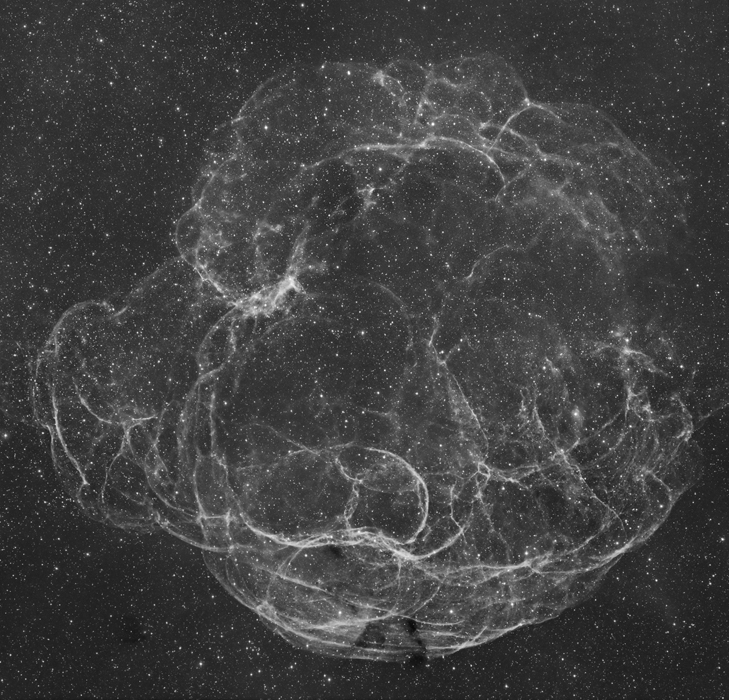Simeis
Simeis 147 (SH2-240) in Hydrogen Alpha
Characteristics:
FOV: approximately 3.9 x
3.9 degrees (two panel mosaic)
RA (J2000): 05h 43m 12s
Dec (J2000): +28 degrees 17' 00"
Position Angle: +0 degrees
Description:
Simeis 147 is a very faint, very large supernova remnant in Taurus that
is expanding at a rate of 1000 kilometers/second. It covers an
area of over 3 degrees of sky and is just barely included in this two
frame mosaic using the STL11K in combination with the FSQ106
scope. Simeis 147 is a result of a supernova explosion that
occurred approximately 30,000 years ago, and the remaining pulsar has
been recently
identified. A supernova results from a massive star (at least
8 solar masses) that has used up most of its elements through fusion,
converting hydrogen to helium, oxygen, silicon, sulfur, calcium, gold,
and eventually iron. Iron is not a viable fuel for fusion (it
requires too much energy), meaning that this element represents the end
of the line for a dying star. Without the outward force of
fusion-induced radiation, the star collapses under its own gravity,
resulting in a massive explosion and release of radiation, some of
which we see as visible light. The stellar remnant of a supernova
explosion is a neutron star or a black hole (depending upon the size of
the residual star). If the residual star is between 1.44 and 3
solar masses, it forms a neutron star (which is also known as a pulsar,
as is the case for Simeis 147). If it is greater than 3 solar
masses, it forms a black hole. I will eventually add color to
this image, but thought that I would post the hydrogen alpha version
first since it contains a great deal of interesting detail.
Photographic
Details:
Date: Ha- October 22, 2007 (bottom half); December 13, 2008 (top
half). The years are correct- I did not get a chance to acquire
the top half of this image until now!
Scope: Takahashi
FSQ106 at f5 on the Takahashi NJP
Mount
Autoguider: SBIG ST-402 with
60mm guidescope, focal length 227mm
Camera: STL11K -20C
Filters: Baader 7nm
Ha filter, 50.8mm
unmounted
Exposures: Ha for
each half was 210'; Total
exposure 7 hours
Post-processing:
Calibrated, aligned, and Sigma Clip combined
in Maxim, followed
by DDP
in ImagesPlus (IP). Further processing in Photoshop CS (16
bit format)
Please
note: Graphics on this website may not be reproduced without
author permission.
Back to Hydrogen Alpha
Home

